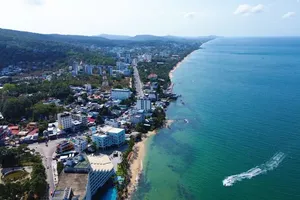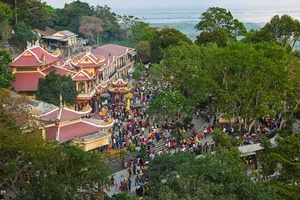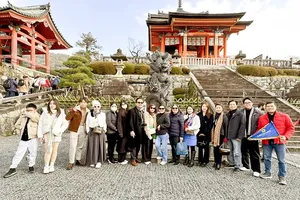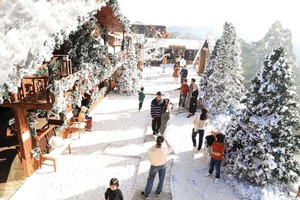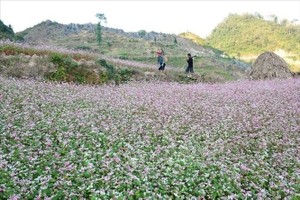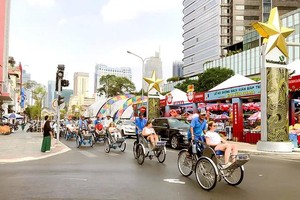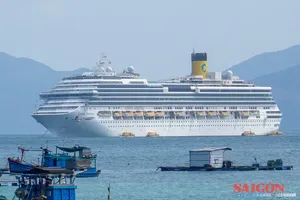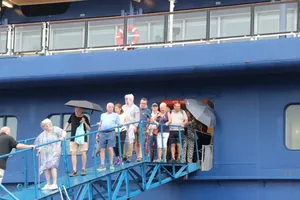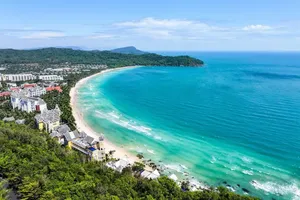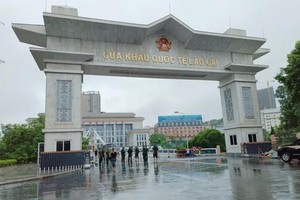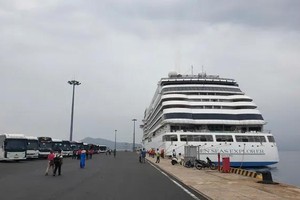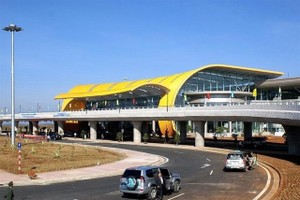The rowers cleave the water leading our wooden boat to graze along the river. Rowing between mountains, we suddenly heard whooping, chattering sounds. There they are. Delacour’s langurs are looming in the leaves above us.
How lucky we are.
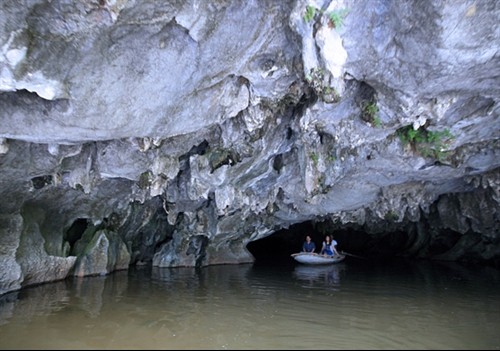
The langurs “with white trousers,” as local people call them, are a critically endangered animal on the Red List of the International Union for Conservation of Nature and Natural Resources (IUCN).
Many people flock to Vân Long Nature Reserve, an area of 2,600ha comprised of a lagoon surrounded by mountains and forests. They come to see one of the rarest and most endangered primates in the world, but only a few lucky tourists get the chance to see them, according to Nguyễn Thị Lý, our boat-woman.
After leading us to visit some caves and enjoy the spectacular view of Vân Long Nature Reserve in the morning, she suggested that we row along another route to find the langurs. They are not easy to spot, but the chances are higher in the afternoon. This time, our experienced boat-woman was right.
Our one-day trip to Vân Long Nature Reserve, which is 80km from Hà Nội, was well worth while and unforgettable.
Set amid glorious limestone pinnacles, this tranquil reserve’s reedy wetlands are popular with bird-watchers. Among the bird species that have been spotted here are the rare black-faced spoonbill, the cotton pygmy goose and the white-browed crake.
The water is transparent and we can see straight down to water plants and algae at the bottom. The mountains are reflected endlessly in the water, creating a picturesque landscape and a rich ecological system. It’s not hard to understand why the film crew for Kong: Skull Island selected Vân Long Nature Reserve as one of several sites to shoot the film in Việt Nam.
Director Jordan Vogt Robert visited the site and was immediately and totally charmed. He decided to shoot the blockbuster movie at the Vân Long Nature Reserve in the northern province of Ninh Bình, as well as at the nearby Tràng An Complex and Tam Cốc – Bích Động site.
A tourist from Ipswich, England who gave his name as Treens, said Vân Long is a great place to visit, and a must-see if you are interested in the critically endangered Delacour’s Langur. He talked about his boat trip to see the langurs.
The boat sat close to the waterline unladen, and by the time two large Westerners and one small Vietnamese had boarded, the water was literally 1cm from the lip of the boat. No-one seemed overly concerned though, and off they went onto the lake. They were the only tourists on site at the time.
“The day was very misty and it was really atmospheric out on the lake with the limestone hills rising up in the background. After half an hour we caught sight of what we had hoped to see - a group of Delacour’s Langurs come down to the lakeside to drink.”
“We watched them and took photographs for 15 minutes before heading back to the landing stage,” he said.
Vân Long Nature Reserve is a legendary land and has amazingly beautiful scenery for tourism, while at the same time, it contains the largest mangrove nature reserve in the northern delta.
Along with Tràng An Complex and Tam Cốc-Bích Động National Park in the province, Vân Long Nature Reserve is considered an overland equivalent of Hạ Long Bay, with imposing cliffs and mountains and vast lakes that form stunning scenes.
In my opinion, each location has its own attraction. At the Vân Long Nature Reserve, it’s the rich ecosystem. Rowing the boat for over two hours to explore the site and visit the caves, we saw many birds.
A sightseeing trip by boat costs VNĐ75,000 (nearly US$3.5) per adult. Tourists should take the tour early in the morning to see nature at dawn, or late in the afternoon to admire the breathtaking view of flocks of storks returning to their nests at sunset.
Vân Long has 33 caves of different sizes, but only some of them are open to tourists. The caves are named after the beautiful grottoes that can be found inside, such as Fish, Tortoise, Book Box, Stone Table and Fairy.
On the way to enter the caves, tourists can see Mèo Cào (Cat Scratching) Mountain, which displays natural formations that make it look like a giant cat scratched upon its slopes centuries ago.
The site is a place where tourists can find peace in a tranquil atmosphere. Although opened for tourism in 1998, it’s still as primitive as it ever was. There are no vendors or shops around, so the touristy vibe is missing. It remains an attractive destination for local and foreign visitors.



